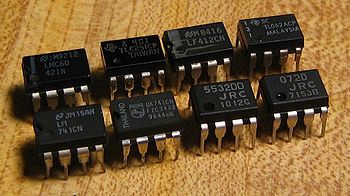Typically the op-amp's very large gain is controlled by negative feedback, which largely determines the magnitude of its output ("closed-loop") voltage gain in amplifier applications, or the transfer function required (in analog computers). Without negative feedback, and perhaps with positive feedback for regeneration, an op-amp essentially acts as a comparator. High input impedance at the input terminals (ideally infinite) and low output impedance at the output terminal(s) (ideally zero) are important typical characteristics.
Section 1—Basic Circuits
- Inverting Amplifier
- Non-Inverting Amplifier
- Difference Amplifier
- Inverting Summing Amplifier
- Non-Inverting Summing Amplifier
- Inverting Amplifier with High Input Impedance
- Fast Inverting Amplifier with High Input Impedance
- Non-Inverting AC Amplifier
- Practical Differentiator
- Integrator
- Fast Integrator
- Current to Voltage Converter
- Circuit for Operating the LM101
- without a Negative Supply
- Circuit for Generating the Second Positive Voltage
- Neutralizing Input Capacitance to Optimize Response Time
- Voltage Comparator for Driving DTL or TTL Integrated Circuits
- Integrator with Bias Current Compensation
- Threshold Detector for Photodiodes
- Double-Ended Limit Detector
- Multiple Aperture Window Discriminator
- Offset Voltage Adjustment for Inverting Amplifiers Using Any Type of Feedback Element
- Offset Voltage Adjustment for Non-Inverting Amplifiers Using Any Type of Feedback Element
- Offset Voltage Adjustment for Voltage Followers
- Offset Voltage Adjustment for Differential Amplifiers
- Offset Voltage Adjustment for Inverting Amplifiers Using 10k Source Resistance or Less
Section 2 — Signal Generation
- Low Frequency Sine Wave Generator with Quadrature Output
- High Frequency Sine Wave Generator with Quadrature Output
- Free-Running Multivibrator
- Wein Bridge Sine Wave Oscillator
- Function Generator
- Pulse Width Modulator
- Bilateral Current Source
- Wein Bridge Oscillator with FET Amplitude Stabilization
- Low Power Supply for Integrated Circuit Testing
- Positive Voltage Reference
- Negative Voltage Reference
- Precision Current Sink
- Precision Current Source
Section 3 — Signal Processing
- Differential-Input Instrumentation Amplifier
- Variable Gain, Differential-Input Instrumentation Amplifier
- Instrumentation Amplifier with ±100 Volt Common Mode Range
- Instrumentation Amplifier with ±10 Volt Common Mode Range
- High Input Impedance Instrumentation Amplifier
- Bridge Amplifier with Low Noise Compensation
- Bridge Amplifier
- Precision Diode
- Precision Clamp
- Fast Half Wave Rectifier
- Precision AC to DC Converter
- Low Drift Peak Detector
- Absolute Value Amplifier with Polarity Detector
- Sample and Hold
- Low Drift Integrator
- Fast Summing Amplifier with Low Input Current
- Fast Integrator with Low Input Current
- Adjustable Q Notch Filter
- Easily Tuned Notch Filter
- Tuned Circuit
- Two-Stage Tuned Circuit
- Negative Capacitance Multiplier
- Variable Capacitance Multiplier
- Simulated Inductor
- Capacitance Multiplier
- High Pass Active Filter
- Low Pass Active Filter
- Nonlinear Operational Amplifier with Temperature Compensated Breakpoints
- Current Monitor
- Saturating Servo Preamplifier with Rate Feedback
- Power Booster
- Analog Multiplier
- Long Interval Timer
- Fast Zero Crossing Detector
- Amplifier for Piezoelectric Transducer
- Temperature Probe
- Photodiode Amplifier
- High Input Impedance AC Follower
- Temperature Compensated Logarithmic Converter
- Root Extractor
- Multiplier/Divider
- Cube Generator
- Fast Log Generator
- Anti-Log Generator












